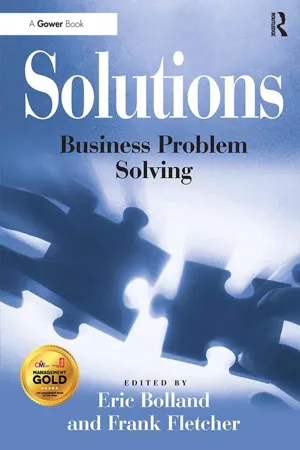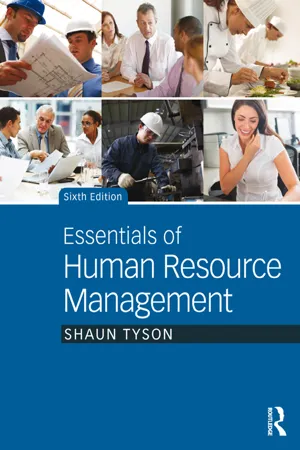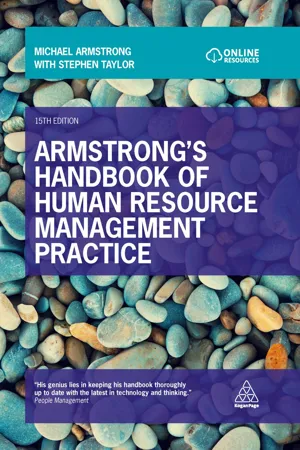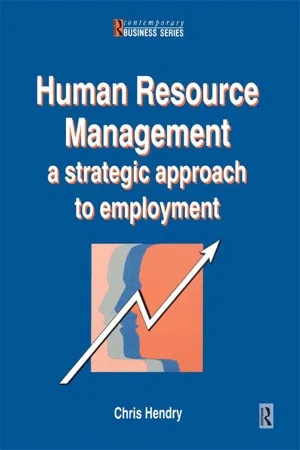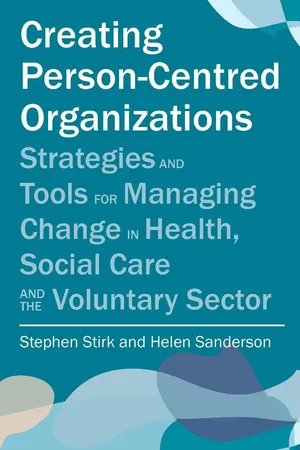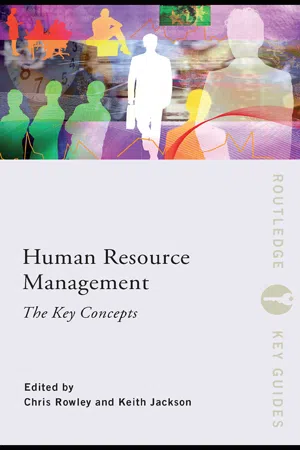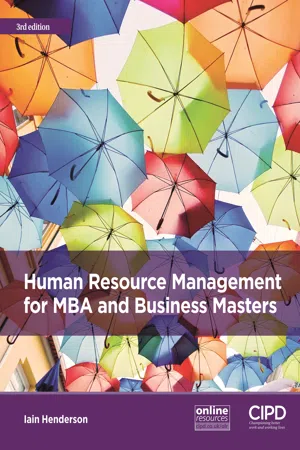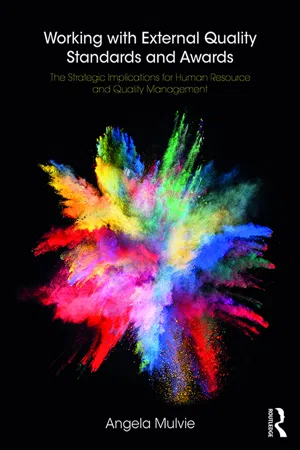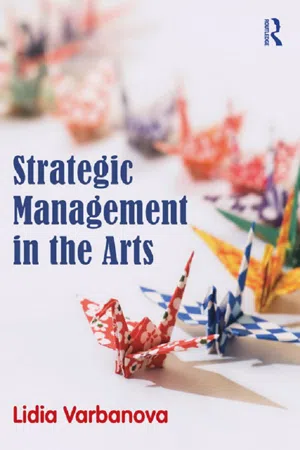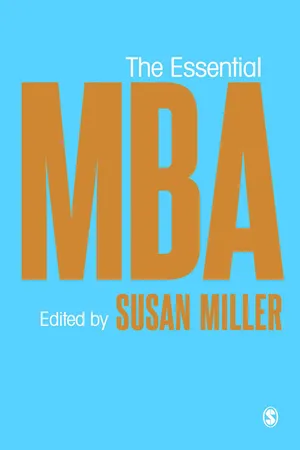Business
Human Resource Management
Human Resource Management involves the strategic approach to managing an organization's workforce. It encompasses activities such as recruitment, training, performance management, and employee relations. The primary goal is to maximize employee performance to achieve the organization's objectives.
Written by Perlego with AI-assistance
Related key terms
11 Key excerpts on "Human Resource Management"
- eBook - ePub
- Simon Chadwick, Simon Chadwick, Sean Hamil(Authors)
- 2010(Publication Date)
- Routledge(Publisher)
Rather than focusing on the key functions of HRM, such as selection, training, induction, performance, and management, as other texts have done (see Wendell Braithwaite in Beech and Chadwick, 2002; Whitrod Brown and Green, 2001 ; Wolsey and Whitrod Brown, 2003), this chapter concentrates on the link between HRM and organisational performance (Becker and Huselid, 1998) and its relevance for sport. Ultimately, if managers and boards of directors are not convinced that HRM will enhance outcomes such as organisational and employee performance, they are unlikely to invest in it. What is Human Resource Management? Human Resource Management (HRM) is the term used to represent that part of an organisation’s activities that is concerned with the recruitment, development, and management of its employees (Wall and Wood, 2005). HRM seeks to provide a strategic approach to managing people, developing commitment rather than controlling, with the spotlight firmly on the individual and the positive and full utilisation of human capital in organisations (Guest, 1990). The traditional need for human resource planning and the functions offered by “personnel” departments have being overtaken by a more progressive view of the key role of people within organisations (Wolsey and Whitrod Brown, 2003). Slack (1997) suggested that strategic HRM, underpinned by an HR philosophy, is about matching HRM activities and policy to business strategy and treating the people in the organisation as strategic resources in the achievement of competitive strategy. Sport, which was previously amateur, has moved to become a professionally focused activity. In a sport organisation, the human resource function may range from the simple maintenance of employee records to designing complex personnel training and development systems, negotiating remuneration, and dealing with grievances (Slack, 1997) - eBook - ePub
Solutions
Business Problem Solving
- Frank Fletcher, Eric Bolland, Eric Bolland(Authors)
- 2016(Publication Date)
- Routledge(Publisher)
CHAPTER 7 Human Resource Management SAL MIRZA and CORINNE FARNETIThe phrase Human Resource Management (HRM) brings about a diverse array of thoughts, emotions and reactions. For many, these can be negative. What have I done wrong? What new policy will I have to adopt? What data do I need to provide? Or even, what now? The human resource department historically has been viewed by employees as nothing more than an administrative bureaucracy that contributes little to the organization’s productivity. However, these impressions and the role of HRM have been shifting over the past several decades.Changes in the business environment, such as the adoption of the innovative workplace, the increasing diversity of the labor force, work-life balance issues and globalization have resulted in a shift away from traditional Human Resource Management. The focus has moved from employee advocacy to a strategic partner. HRM concerns and concepts are integrated into the strategic plan of the organization. HRM is now primarily concerned with developing human resource practices that enhance a firm’s competitive advantage through its most valued asset, its people.The human resources (HR) function can provide significant support and advice to management. The attraction, development, and retention of high caliber people are a source of competitive advantage for your business, and are the joint responsibility of HR and management. HRM is no longer just the responsibility of the human resource department. CEOs, directors, department heads, middle managers and line managers are also increasingly concerned with these tasks. Managers now have increased accountability for their direct reports in the areas of hiring, development, succession planning and performance management.You as a manager will have to align your human resources through integration of decisions about your employees with decisions about specific organizational goals. This chapter offers HR professionals and organization managers processes, tools and resources to make informed HR decisions. - eBook - ePub
- Shaun Tyson(Author)
- 2014(Publication Date)
- Routledge(Publisher)
We can venture a description of what lies at the heart of managerial work. The essential characteristics seem to be that managers exercise their authority in such a way that it is regarded as legitimate, they maintain the adherence of subordinates to the organization’s goals and build teams that are capable of achieving these goals. Human Resource Management in its specialized sense is concerned to help in the widest possible way with these managerial tasks. The human resource function has organization-wide responsibilities for HR policy, and should be considered as quite separate from the function which all managers carry out when managing people.The activities of the specialist occupation, now commonly called ‘Human Resource Management’ (HRM), are concerned with all aspects of the employment relationship – from start to finish of the employment life cycle.These activities are listed below, covering all the stages of employment.Strategic Framework
The activities referred to above include the following:- the creation of HR strategy to give effect to the business strategy
- designing organization structures, accountabilities, formal reporting relationships, geographical locations
- setting up workforce planning systems, E-HRM platforms
- creating policies and systems, and rules of work to deliver them
- designing the employee offer/linking employer brand values to marketing strategy
- reward strategy
- employee relations strategy.
Establishing the Employment Practices
- recruitment policies/practices
- diversity management policies
- selection
- induction.
Total Reward Policies
- job evaluation
- pay policies
- hours of work/contractual arrangements
- incentive schemes
- pensions and benefits
- working climate
- job design
- team based rewards.
Development and Talent Management
- performance appraisal/identification of potential
- Michael Armstrong, Stephen Taylor(Authors)
- 2020(Publication Date)
- Kogan Page(Publisher)
PART IFundamentals of Human Resource Management
PART I CONTENTS- 01 Human Resource Management
- 02 Strategic HRM
- 03 HR strategy
- 04 Human capital management
- 05 The context of HRM
- 06 HRM and performance
- 07 International HRM
Introduction
HRM is about the management of people in order to achieve desired results.The first chapter in this part of the handbook covers the conceptual basis of Human Resource Management, including the various HRM models and the characteristics of an HR system. It also examines the case for a different approach to HRM through people management. The second chapter deals with the nature of strategic HRM. This is followed by a chapter on HR strategy that describes how the strategic HRM concept functions in practice. The following chapters deal with the associated concept of human capital manaement, the importance of the context in which HRM takes place, the ways in which HRM affects performance and the practice of international HRM.Passage contains an image
01Human Resource Management
Introduction
Human Resource Management (HRM) is about how people are employed, managed and developed in organizations. HRM is delivered by means of the HR system, which operates within the framework provided by the HR architecture.The term ‘human resources’ is controversial. Osterby and Coster (1992: 31) argued that it ‘reduces people to the same category of value as materials, money and technology – all resources, and resources are only valuable to the extent they can be exploited or leveraged into economic value.’ There has therefore been a move to replace ‘human resources’ with ‘people management’ and a proposal on what the latter could mean is made at the end of this chapter. But HRM is still the most commonly used term.Words of wisdomMany texts and dictionaries mistakenly define ‘human resources’ as the people employed in an organization, a notion that obscures the meaning of human resources and that critics see as impugning the dignity and denying the independence of human agents. Human resources are more accurately understood as the resources that are intrinsic to human beings, which they can apply to the various tasks of life.- eBook - ePub
- Chris Hendry(Author)
- 2012(Publication Date)
- Routledge(Publisher)
1 Human Resource Management: an overview
DOI: 10.4324/9780080517872-1Introduction
Human Resource Management (HRM) has gained rapid and widespread acceptance as a new term for managing employment. It remains, however, an ambiguous concept. People question whether it is any different from traditional personnel management, nor is it altogether clear what it consists of in practice.This chapter sets out the background of ideas on which HRM is based. Three common interpretations are identified. HRM is then compared with personnel management, identifying the special shortcomings of personnel management and those it shares with HRM.The chapter concludes by setting out the approach adopted in this book. This combines a view of organizations as employment systems set against the requirement to manage organizations in accordance with current business strategy.What do we mean by HRM?
Our starting point is that HRM has different connotations for different people and does not yet constitute a unified theory. We are all familiar with such statements as ‘our human resources are our most important asset’. In some cases, acceptance of the principles of HRM goes no further than this. Others emphasize that it is about matching employment practices to an organization's strategy. A corollary of this is that, taken as a whole, employment practices should combine together to reinforce one another. Part of this is that employment decisions should not be conceived in isolation, but ideally should be integrated through mechanisms such as personnel planning. At the same time, reward systems, the way promotions are made, who gets trained and why, all have effects on motivation and say something about what kind of organization it is and what behaviours it wants to promote. HRM is about making sure such personnel practices convey a consistent message.A third connotation is to present HRM as having a distinctive philosophy underpinning it, not just any set of values. This philosophy emphasizes securing employee commitment and motivation in organizations characterized by high-trust relations, with scope for employees to exercise influence. Management style and organizational culture then become an important focus for action in their own right. It is not enough that employment practices cohere, nor even that they should express the values of the organization. These values are of a particular kind. - eBook - ePub
Creating Person-Centred Organisations
Strategies and Tools for Managing Change in Health, Social Care and the Voluntary Sector
- Stephen Stirk, Helen Sanderson(Authors)
- 2012(Publication Date)
- Jessica Kingsley Publishers(Publisher)
Chapter 8
Human Resource Management
I believe in the adage: ‘hire people smarter than you and get out of their way’.Howard Schultze, CEO of coffee chain Starbucks (1994)85Introduction
Our success in living our values and fulfilling our mission requires working closely together. Human resources (HR) is about bringing the best out of the organisation’s most valued assets – the people who work there – and ensuring that their individual and collective contributions come together to achieve the mission.86 This combination of tools and techniques also goes under the names of personnel management, people management or people development, but essentially makes up all the ways that we have of dealing with the relationship between an organisation and the people who work for it.One simple definition is that Human Resource Management is the process of matching individual staff and their contributions to the people supported and the organisation. The person-centred thinking Matching tool has a powerful contribution to make here. Getting the right staff to support people, well matched in relation to the support the person needs, their personality characteristics and ideally shared interests, is key to great Human Resource Management.This chapter demonstrates how an integrated approach using person-centred practices with established human resources approaches can ensure that the talents and commitment of staff make a difference to the people supported.What does Human Resource Management mean in a person-centred organisation?
The soft stuff is always harder than the hard stuff. (Roger Enrico, Vice Chairman of PepsiCo, referring to areas such as HRM as opposed to quantitative factors in Fortune , 27 November 1995)87It depends on what you define as hard and soft, but we would tend to agree that dealing with the myriad of diverse people we come into contact with is much harder than measuring widgets, and just as hard to know when you are actually getting it right. Too often we stifle talent and creativity, or even just contribution, by being too prescriptive about what we do and how we do it. When we talk about human resources management (HRM) in this chapter, we mean both what first-line and other managers do, as well as what an HR team may be responsible for. In keeping with the value of decision making happening as close to the person supported as possible, most of the recruiting process and certainly the selection decision for new staff would take place at an individual level – with the person and the manager of their service, not done by a central HR team. The HR team’s role here is in establishing a flexible, person-centred framework and processes that reflect the values of the organisation, and in taking the administrative and transactional burden away from managers so that they can focus on the quality of the selection decision. - eBook - ePub
- Chris Rowley, Keith Jackson(Authors)
- 2010(Publication Date)
- Routledge(Publisher)
From a modern HRM perspective, two main interpretations of the term ‘talent’ appear to obtain: one broad, and the other relatively narrow. The broad view suggests that all employees have talent, i.e. the potential for professional development and growth and a level of performance relevant to the organisation. Logically, organisations in the education business or health care sectors might be expected to adopt this broader view. However, most business organisations do not have sufficient resources – nor, probably, the strategic intention – to develop all the talents available to them. Consequently, they will tend to adopt a narrower definition and focus their resources on attracting and retaining, motivating, rewarding and committing a chosen few so-called ‘high performers’, calculating that the return on investment in this narrowed group of employees is likely to be higher and more assured. Thus, in most HRM contexts, reference to talent tends to assume a special case.Managing ‘talent’ in organisations
It would be fair to argue that managing talent (however defined) should be no different to the effective management of people or any diverse group of employees. Consequently, it is valid to subsume an analysis of effective talent management under discussions of ‘managing diversity’. Nonetheless, and given the emerging global currency of the concept, HR professionals are challenged to manage talent effectively. A whole HRM sub-industry has emerged offering practitioners advice about how to do this. To illustrate: Armstrong (2006: 390) defines talent management as ‘the use of an integrated set of activities to ensure that the organisation attracts, retains, motivates and develops the talented people it needs now and in the future’. Effective talent management, he suggests further, would ‘secure the flow of talent, bearing in mind that talent is a major corporate resource’ – and, we can assume, a globally scarce resource. In his ‘handbook’ of HRM practice, Armstrong (2006) devotes a substantial chapter to talent management, locating it between human resource planning , recruitment , and selection - Iain Henderson(Author)
- 2017(Publication Date)
- CIPD - Kogan Page(Publisher)
et al 2007). This means something more than just ensuring compliance with legal protection for employees with respect to health and safety at work and against discrimination in employment.1.12 SUMMING UP
In today’s and tomorrow’s world, sustainable competitive advantage can only come from the skills, experience, creativity, imagination and brainpower of people. In the modern economy it is relatively easy to raise capital to fund a bright idea, but managing the human resources of an organisation to turn that idea into a business and achieve sustainable competitive advantage – how to create and build the next Google or Facebook or Apple – is the single most important management challenge in the twenty-first century.HRM is now the dominant paradigm in people management. It seeks commitment from employees rather than compliance; it tends to be unitarist rather than pluralistic in its approach to employee relations; and it places great emphasis on taking a strategic approach to human resources.In this chapter we have explored the nature of HRM and how it evolved and have looked at some of the key contemporary themes in the management of people in modern organisations. These themes are examined in more detail in later chapters.EXPLORE FURTHER
Armstrong, M. (2014) Armstrong’s Handbook of Human Resource Management Practice. 13th edition. London: Kogan Page.- Chapter 1 , ‘The essence of Human Resource Management’; and Chapter 2 , ‘Strategic HRM’.
- These chapters provide brief overviews of their topics, useful for quick reference and starting exam revision.
Boxall, P. and Purcell, J. (2006) Strategy and Human Resource Management. Basingstoke: Palgrave Macmillan.- Chapter 1 , ‘Human Resource Management and business performance’ – this is a scholarly introduction to HRM which makes explicit linkage to business performance.
Boxall, P., Purcell, J. and Wright, P. (eds) (2007) The Oxford Handbook of Human Resource Management- eBook - ePub
Working with External Quality Standards and Awards
The Strategic Implications for Human Resource and Quality Management
- Angela Mulvie(Author)
- 2018(Publication Date)
- Routledge(Publisher)
The move away from helping employees and caring for their welfare was replaced by a much more rigorous focus on the effectiveness of people utilization to a business. Descriptions of employees as assets and/or resources replaced earlier terminology, reflecting changes within the field of practice where personnel management was replaced by the concept of HRM. Indeed, a whole field of study has emerged known as strategic HRM. Salaman and Asch (2003) consider that the bringing together of the two subjects of strategy and HRM has resulted in exciting new areas of both academic research and practitioner activity. They argue that realigning the relationship between the three key factors of environment, strategy and organizational capability, lie at the heart of attempts to improve organizational performance. Organizations change to improve the fit between themselves and their strategy; performance can be enhanced by the application of best-practice processes; the organization can build on its existing strengths and capabilities; innovative and intelligent strategies will help to make change; and the degree of adaptability within the organization and its members will also be a key influence (Salaman and Asch, 2003). Many if not all of these factors can be found within the application of QM activities, in that field’s search for best practices. Indeed, arguably the search for best practices in all areas of business becomes the area of common ground between the two disciplines, when organizations are working with external quality standards. Yet the potential for conflict regarding the ownership and management of a quality-related project may exist unless clear agreement on boundaries and levels of cooperation is present - eBook - ePub
- Lidia Varbanova(Author)
- 2013(Publication Date)
- Routledge(Publisher)
- Analyse all internal regulations and working conditions. Think of effective ways to change them (where needed ).
- Plan carefully the recruitment and selection process for full-time, part-time and volunteer staff.
- Evaluate to what extent your organisation is a learning organisation.
- Develop concrete strategies for personnel motivation, education and development.
- Calculate the cost-effectiveness of professional development for the current staff members. Find ways to improve their skills and competences, where possible.
- Calculate the cost implications of personnel changes and implementation of planned HRM strategies.
- Synchronize the HRM section with other sections of the strategic plan.
- Suggest ways to secure the necessary financial resources to implement your HRM plan. Connect it with the financial and fundraising section of the plan.
7. EXAMPLE OF A ‘Human Resource Management’ SECTION OF A STRATEGIC PLAN
- Main Human Resource Management strategies and objectives (rationale for the choice and short description). Explain which main strategies and objectives for human resources management you have chosen and why. Give arguments for how they are connected and help in realizing the general organisational objectives.
- Main strategic changes planned in the organisational structure (if any).
Include here:
- Problematic areas in the current organisational structure;
- Organisational chart of a future (desired) structure and approach towards changing it to facilitate an intrapreneurial climate;
- Job descriptions of the key positions (changes and improvements in the current ones; creation of new positions).
- eBook - ePub
- Susan Miller, Susan Miller(Authors)
- 2011(Publication Date)
- SAGE Publications Ltd(Publisher)
In advancing a discursive analysis of HRM, Keenoy (2009) also considers a search for an essential definition of HRM as unwarranted. Instead, since discourses are both historically situated and culturally conditioned, then a term such as HRM is best viewed as, ‘a generic term with a range of possible culturally situated meanings’ (2009: 457). Marchington and Grugelis (2000) earlier noted concern that Pfeffer’s (1998) advocacy of teamwork might instead involve work intensification highlights this. Here there might be what Keenoy would consider to be a tension in the framing of HR practices and the enactment of these HR practices. Keenoy is also critical of the manner in which the academic construction of HRM took a distinctively managerialist turn in prioritizing employee performativity. Specifically referencing the work of Guest (1987) and Storey (1992) he contends that their work resonates with neoliberalism and frames HRM as a prescriptive unitarist endeavour. Work by those trying to establish a link between HRM and performance, whether in the form of best practice or best fit, Keenoy views as a project with ‘obvious normative appeal’ (2009: 461). This we might consider paradoxical since those engaging in such research would typically view themselves and what they do as rigorous social science based on robust empirical evidence and largely devoid of a normative dimension. This becomes another criticism which Keenoy lays at the door of mainstream writings on HRM as he forwards a trenchant critique of the methodological flaws of such writings.Summary
This chapter has introduced some of the key issues which relate to HRM. It has discussed what HRM is, as well its historical development in the UK. The chapter then examined work which links strategy, HRM and organizational performance. A number of criticisms of such work were also identified. On the basis that this work has been criticized in relation to a conceptually limited view of the employment relationship, the chapter went on to argue that HRM needs to place the employment relationship at the centre of its analysis. This is contrary to some criticism which argues that it is too narrowly focussed around managerial concerns alone, in the process ignoring or downplaying employees’ role and need to be part of any analysis relating to employment management. In discussing the employment relationship the chapter focussed on the different perspectives which can help us see that the employment relationship has been argued to be a relationship in which there are tensions, contradictions and different interests on the part of employers and employees. Finally, an overview was presented which highlighted the need to understand the employment relationship as a multi-dimensional concept. It was argued that while economics matter we must also take account of power in order to understand what can and does occur within employment management.
Index pages curate the most relevant extracts from our library of academic textbooks. They’ve been created using an in-house natural language model (NLM), each adding context and meaning to key research topics.

